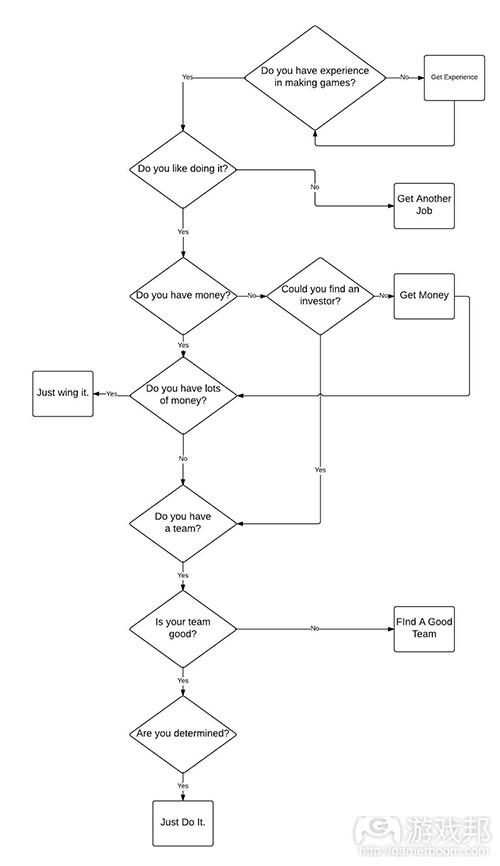如何创建一家属于自己的独立工作室?
作者:Jeremy Lam
所以你是否想要创建一家独立工作室?
作为一家小型独立工作室的拥有者,我总是被问到同样的问题:“我是否应该创建自己的工作室?”
这一问题的答案非常复杂,以下便是相关的决策树:
好吧,或许决策树没有那么复杂。玩笑之余让我们看看游戏设计师,美术师,动画师,程序员等人在创建自己的独立工作室时都需要考虑的一些主要内容。
在你开始开发前,你必须确保自己拥有一支合适的团队和一个合适的理念:
1.确保你的团队的首席美术师能够有效传达出游戏的美学。让他们从一些较大(或最大)的图像开始创造。这里不需要概念设计,更加需要清楚,简单且能够传达最终产品的精确模型。这将能够长时间鼓舞团队成员并保持愿景不变。
2.确保首席程序员拥有所需技能,敏捷性与敏锐的观察力。前面两点是毋庸置疑的,但我们却经常忽略最后一点。因为你可能没有能力去雇佣一名技术美工,所以你的首席程序员便需要拥有敏锐的观察力去传达第1点中所呈现的游戏美学。
3.如果你的游戏是基于全新理念的游戏,你便需要确保能够从游戏原型开始。然而你也不能为了创造原型去创造原型。对你的游戏设计提问,然后想出这些问题的答案。如果你不知道自己想要知道什么,你便需要暂时停下来去好好想想这一问题。你不需要为《Flappy Bird》复制内容创建原型,除非你的游戏拥有一个截然不同的功能。
4.无需任何资金或特殊装备你便能够轻松完成第1至第3点。至少在做出任何投资前你必须先执行前面3点内容。
5.在经历第4点后你的团队的疑虑便会大大减少。
6.不要陷入沉默成本误区中。如果你的团队不喜欢游戏理念,你便可以重新经历第1至第5点。
7.如果你的游戏规模太大而难以基于这种方式进行测试,你便需要调整目标。千万不要逞强去做那些超过你力所能及范围的事。
在开始开发后(游戏邦注:即签订了合同,获得了投资,租了办公室并购买了装备后)你需要:
1.专注于你所创建原型的游戏。
2.专注于一个平台。最好是iOS。没错,我很喜欢iOS,但我这么说也是有原因的:
从整体看来iOS拥有更高质量的用户(更高的ARPU)。
在这里你无需测试大量设备以及较小的OS版本。
苹果的App Store非常有纪律性。如果你的游戏足够有趣且外观足够吸引人,你便更有可能获得它的推荐。帮助你瞄准这一目标的一种方法便是与最近获得推荐的开发者保持友好关系并让对方将你引荐给苹果的编辑。“最佳新游戏”类别的推荐能够带给你很大的帮助。
注意:他们可能不会告诉你你被推荐了。美国的App Store经常会在周四(太平洋夏令时)下午1点的时候更新首页内容。所以请确保在这之前准备好你的应用,并不断祈祷。即使你未获得推荐也不要气馁。
如果你将游戏广告作为盈利策略,那么比起Android你将在iOS上获得更高的eCPM(即千人印象成本)。
Google Play允许你能够更快地提交并反复迭代内容,但是一旦你明确了自己正在做什么,那么一周的部署周期便足够了。
3.为自己设定许多里程碑(可能每周一个)从而让你能够更好地衡量自己的发展。
4.为了更好地进行调整与优化你应该在最后添加20%至30%的缓冲时间。
5.你必须尽量获得更多反馈。尽早进行测试。看看以下视频:
6.https://www.youtube.com/watch?v=rDjrOaoHz9s
7.也许你也需要一定数量的市场营销成本。5千至1万美元足以帮你获取一定数量的用户。不要太过依赖于应用商店推荐。
8.总之,你应该真诚地创造产品并巧妙地对待发行。
这便是我对于如何创建一家独立工作室的概括,虽然我可能会遗漏某些内容,但这些都是我在创建PIXIO过程中所认为的最重要的内容/问题。
(本文为游戏邦/gamerboom.com编译,拒绝任何不保留版权的转发,如需转载请联系:游戏邦)
So you want to start an indie studio?
by Jeremy Lam
So you want to start an indie studio?
As an owner of a small indie studio, I get asked the same question over and over again: “Should I start my own studio?”
The answer is extremely complex so without having to write a whole essay about it, here’s the decision tree:
Okay, so maybe the decision tree isn’t that sophisticated. Jokes aside, here are some major points that any Game Designer/Artist/Animator/Programmer/Others have to consider when starting their indie studio.
Before you start development, make sure you have the right team and the right idea:
1.Make sure the lead artist of your team can deliver the aesthetics of your game. Have them start from the bigger (or biggest) picture and work their way down. Not concept art, but clear, concise mockups that resemble the final product. This goes a long way in inspiring the team and unifying the vision.
2.Make sure the lead programmer has the skills, agility and eye for detail. The first two are no brainers, but the last point is often forgotten. Since you probably won’t have the luxury of hiring a technical artist, the lead (and often sole) programmer would have to have an eye for detail to effectively deliver the aesthetics stated in point 1.
3.If your game is not pre-proven (lol), make sure you start with a prototype. However don’t make a prototype for the sake of making a prototype. Go in with questions about your game design, and come out with answers. If you don’t know what you want to know, then you’ll have to pause and think. E.g. You don’t need to make a prototype for a flappy bird clone unless you have dramatically different features.
4.Point 1 ~ 3 should be easily doable without any funding/special equipment/office. At least should try to be as far into the first three points as possible before making any real investments.
5.Your team should have little to no doubt about the project after point 4.
6.Don’t fall into the sunk cost fallacy. If the team isn’t happy with the idea, rinse and repeat 1 ~ 5.
7.If the scale of your game is too big to be tested this way, then refocus. Don’t aim for something a small team can’t swallow.
After you start your development (contracts signed, investments made, office rented, equipments acquired…).
1.Focus on that one game you prototyped.
2.Focus on one platform. Best if iOS. And yes I’m what you call a fanboy, but with good reasons:
iOS has higher quality users in general (higher ARPU).
Devices needed for testing is drastically less. Minor OS Version segregation as well.
Apple’s App Store is well curated. If your game is fun and aesthetically pleasing enough (refer to points 1 ~ 5), you’ll have a good chance of getting featured. A good way to aim for this is to befriend someone who has been featured recently, and have him make an introduction to an editor at Apple. A good feature in the “Best New Games” category could go a looong way.
Heads Up: they might not tell you if you get featured. The US app store often changes front page content around 1pm on Thursdays PDT. Make sure your app is ready before then, and pray… Pray a lot. Even if you’re an atheist. Wouldn’t hurt.
If you rely on in game ads as a monetization strategy, you’ll probably see lot higher eCPMs on iOS compared to Android.
Google Play does allow you to submit and reiterate in a quicker manner, but as long as you know what you’re doing, a one week deployment cycle isn’t that bad.
3.Set many milestones for yourself (probably weekly) so you have a good gauge of progress.
4.Add 20~30% of buffer time at the end for fine tuning and polishing.
5.Remember, get LOTS of feedback. Can never hurt to test early. Please watch this video from the awesome guys at Extra Credit:
6.https://www.youtube.com/watch?v=rDjrOaoHz9s
7.Prepare a healthy amount of marketing money. 5-10k USD should be enough for a small initial burst to gain a certain amount of users. Don’t bank on the app store feature too heavily.
8.All in all, be genuine in your product, and be strategic in your launch.
That’s my overgeneralization of how to start an indie studio, and those who’ve made it know that there’s a million things I left out, but those are the points/problems I personally considered/ran into when starting PIXIO. (source:Gamasutra)
上一篇:开发者需要听取来自玩家的声音
下一篇:成功发行一款游戏的6大步骤








































 闽公网安备35020302001549号
闽公网安备35020302001549号